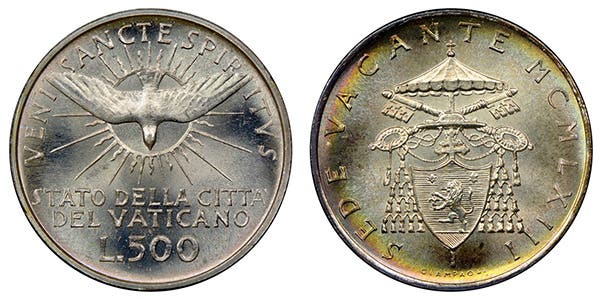Japanese Emergency Coins Resurface
In August 2023, what has since been dubbed “maboroshi” or phantom coins was found in a Shofu Global warehouse used to keep dental equipment.
The recent find of perhaps as many as half a million coins planned to be circulated in Japan during the latter part of World War II may not hold much monetary worth, but the story behind them is of much greater value.
In August 2023, what has since been dubbed “maboroshi” or phantom coins was found in a Shofu Global warehouse used to keep dental equipment. They had been stored loose and in bags in 15 boxes, holding more than 500,000 coins. The coins are now in the possession of the Japanese Mint Bureau, and a donation of 100 coins was presented to Shofu Co Ltd. A Shofu representative commented, “There are unexpected things in expected places.”
Founded as the Shofu Kogyo Company in 1906 in Kyoto, Japan, the company manufactured and exported high-voltage ceramic insulators, chemical porcelain, and various other porcelain and industrial porcelain products. By the late 1930s, it became the leading producer of ceramic dental products in Japan, and its successor, Shofu Global, continues to produce dental materials and equipment today.
The ceramic composition coins were an emergency issue meant for circulation during World War II. The Shofu Kogyo Company produced them for the Mint of Japan in July 1945. Information regarding whether the coins have mint marks is not immediately available. The Shofu Kogyo Company produced about 15 million ceramic 1-sen denomination coins on which Mount Fuji appears on the obverse with cherry blossoms on the other. The coins were produced in Arita, Kyoto, and Seto.
These coins were planned to circulate as an emergency issue, as in the 1943 zinc-coated steel cents in the United States. No further 1-sen coins were minted following the August 15, 1945, surrender of Imperial Japan. Officially, the inventory was destroyed before it entered circulation. The Standard Catalog of World Coins found that the one sen “circulated unofficially for a few days before the end of WWII in central Japan.”
A statement from the Japan Mint reads, “We hope that the recent discovery of so many ceramic coins will lead to new discoveries about the circumstances surrounding currency manufacturing at the end of the Pacific War. " It continues, “We intend to carry out a detailed examination, comparing them with materials preserved in the Mint’s collection. We hope this will provide greater insight into the manufacturing conditions of the period.”
Japan circulated aluminum composition coins in the early 1940s during World War II. The country’s final circulating precious metal coins are the .720 fine silver 50 sen, dated 1938.
JIM or Japanese Invasion Money paper money was used throughout most of the territories it controlled during the war. One notable exception was the 1944 to 1945 red fibrous material 1- and 5-fen coins circulated in Manchukuo (now Manchuria) until the Soviet invasion.
The country issued de facto military scrip in occupied territories through the Southern Development Bank. All local hard currencies were seized beginning at the time of the capture of the Philippines in 1942. According to the November 2, 1945, issue of YANK-The Army Weekly, “The Filipinos knew if the Philippines fell, millions of dollars of national assets in gold, silver, securities, and currency would fall into the hands of the enemy. All the country’s assets were sent to Corregidor Island. It totaled $38 million in U.S. Treasury checks, $31 million in American and Philippine currency, $9 million in silver pesos and over 10,000 pounds of gold worth almost $9 million.”
The gold was safely shipped to Washington, where it was stored for the Philippines government. Regarding the silver Philippine coins, YANK reported, “The only decision left was to dump the remaining silver in Manila Bay to protect it from the enemy and to hopefully recover it later. More than $10 million in silver was dumped at night in Manila Bay just before the final surrender. (These were coins that the Philippine Treasury held as reserve for paper currency.) After the war American salvage ships of the Seventh Fleet performed the recovery operation and recovered 5 million pesos, resulting in the story published in the magazine. Of the 27.5 million pesos dumped in Manila Bay, about 7 million were recovered.” JIM scrip was called “Mickey Mouse money” by local Filipinos; most of it was destroyed following the end of the Japanese occupation.
You may also like:








